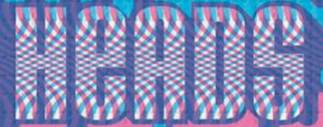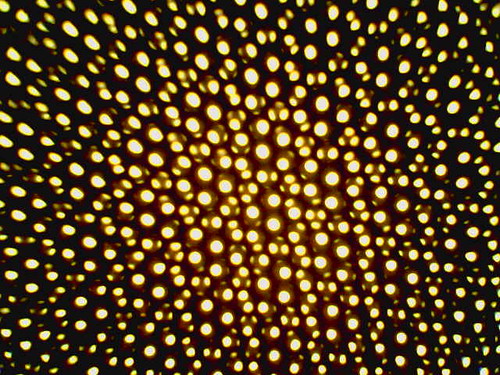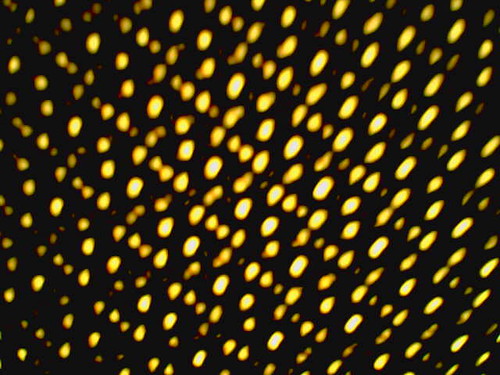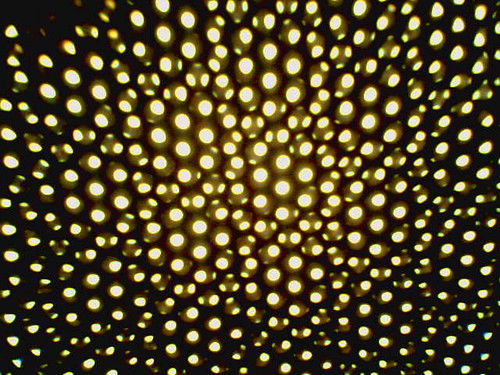(Being an attempt to write short fiction in even shorter increments…)
dead bird, no. 1, no. 2, no. 3, no. 4, no. 5, no. 6, no. 7, no. 8, no. 9, no. 10, no. 11
The dead bird moved a little bit every day. Or, rather, parts of it did. It was separated — a wing over here, something unrecognizable over there — on the weed-cracked sidewalk outside the wonton factory I passed while jogging each afternoon. It was a mostly deserted street.
Late in the bird’s disintegration, I passed someone a little further down the block, walking in the shadow of a warehouse. “Hey!” I wanted to ask him — a prematurely balding Puerto Rican kid who worked in the tire yard –“did you see the bird? It’s been there since March!” It was the end of May then, and I was wondering what the summer sun would do to it. But I kept jogging.
That was the same week I told Monica about the bird.
I’ve already posted my photos and field recordings of my adventures at the 2006 edition of the Consumer Electronics Show, but my reason for being there — the piece I was supposedly writing — kinda fell through the cracks. I pitched this story and went to Las Vegas thinking I was writing a tech-oriented travelogue, only to discover upon my return that my editor had wanted a simple review of the Show’s hottest new gadgets. After another publication promised to run it, it got bumped for adspace, with the intention of running it on the website, at which point it officially fell through the cracks. Half a year later, here it is.
Searching for the Next Little Thing (or A Consumer in a Strange Land)
by Jesse Jarnow
The only reassuring thing about the chaos across the 1.6 million square feet of carpeted exhibit-space at the Consumer Electronics Show, held January 5th through 8th in Las Vegas, is that nobody among its 150,000 participants seemed to know what was going on — which is exactly how I found myself offering fanboy suggestions to one of the dudes from San Jose who invented the iPod’s trademark clickwheel.
We’d both come upon the same CES woman in a yellow information shirt, who’d told us (with stunning inaccuracy) that it was “about a mile” to the other side of the building. She explained why we should wait for the next shuttle bus rather than walk — as we did — down the service driveway and past loading docks stacked high with wooden crates that resembled stage props.
“Tell me,” I asked Clickwheel Dude promptly, “the next generation of iPods is gonna be a cell phone with a faux-modernist rotary dial clickwheel, right?”
“Where’d you hear that?” he asked, mildly taken aback. “No, no,” he said, hinting that a virtual clickwheel could potentially be “extremely tactile.”
“We really need this kind of feedback,” he added.
Once he finally made it through registration and onto the floor of the Las Vegas Convention Center and into the teeming ecosystem of buyers, exhibitors, press, and other non-consumers (mostly dragging roller-suitcases), he would get plenty more.
***
To tramp from the Convention Center’s monorail stop to its furthest rim, attendees crossed more than a mile, from the two-level South Hall (starring Google and their giant Legos), across the massive Central Hall (featuring a Sony floor installation that required its own sub-map), through the bass-booming North Hall (where bikinied booth babes demonstrated the hottest backseat subwoofers), and into the Hilton next door (whose modest stalls sported clever Asian miniaturizations). And that’s not to mention the additional floor at the Sands (conventioneers mingling with silicone-enhanced attendees of the AVN Adult Entertainment Expo, held next door).
Feedback for Clickwheel Dude came on like locusts in a plague. One could barely step without crunching down on the sleek plastic exoskeletons of imitation iPods (like SanDisk’s sporty Samsa, pimped by toned pep-dancers) and artifacts from its attendant cottage industry, including mini-speakers (mostly mimicking Altec Lansing’s popular inMotion), crazy protective shells (H2O Audio’s waterproof pod-cases and earbuds), and teddy bears (Sakar’s SoundPal). If iPods are the present of music, then its future is undoubtedly a world of variations, and — eventually — commonality, cheapness, and Salvation Army bins.
While pundits pontificated about an “iPod killer,” the most innovative products recognized music tech’s new paradigm of flexibility. With ATO’s iSee, users can store videos on regular iPods, dock them in the iSee, and watch them. Many forward-thinking products served as reminders of the entertainment industry’s ongoing copyright wars. Timetrax’s TraxCatcher allows users (with perhaps questionable legality), to snatch individual mp3s from satellite radio systems like Sirius (now starring Howard Stern) and XM (whose roster includes DJ Bob Dylan).
As always (as demonstrated by the latter), the future includes cars with TVs in them (possibly in their trunks), screens that are bigger, and speakers that are louder. The main halls were characterized by a nearly comical largesse that suggested a World’s Fair without the nobility. Utopian living room sets (such as CyberHome’s wireless video network) were interspersed with displays of fantastical architecture (such as DirectTV’s cube-dangling high modernist dreamscape), as well as temporarily constructed meeting rooms that recalled conjugal visit trailers.
Google’s presence was a breath of fresh air, stocking their booth with real live engineers to showcase the Mountain View wunderkinds’ fabbest inventions. Likewise, following a canned Friday morning keynote-cum-product-roll-out from Yahoo CEO Terry Semel (abetted by token celebrities Tom Cruise and Ellen DeGeneres), Google co-wizard Larry Page took the afternoon by storm.
The deliciously geeky opposite of Semel and his fake living room set, Page (in a white lab coat) spun a science fiction vision, pleading for industry-wide standardization in hardware and power supply and inter-gadget communication.
“One wire should do everything possible,” he said. “If you plug a wire into something, you should be able to do anything you could possibly do with that device -– run software on it, charge it, power other devices from its battery, or whatever, just with that single wire. We could basically do that with the hardware we have. And it should work the same whether you plug that wire into your house, your neighbor’s house, or all the way around the world.”
Following the help of his (gloriously freestyling) celebrity, Robin Williams, Page soon introduced Google Video — the search company’s first foray into retail, and their response to Apple’s iTunes store.
Featuring CBS shows, day-old NBA games, and Charlie Rose interviews, Google Video will also sell content by anybody who cares to create it. Much of the major programming will only work on Google’s proprietary viewer, however, preventing users from watching their purchases on their iPods (bummer, Clickwheel Dude).
But the most mindblowing product described by Page wasn’t the integration of Google Earth into mobile phones (though that’s pretty rad), nor was it even made by Google (though they donated $2 million dollars to its development). It was a mock-up of MIT scientist Nicholas Negroponte’s hand-cranked, wifi-enabled, open source $100 laptop. At a convention dedicated to making the world move faster, Google seemed committed to moving the world quantifiably forward.
After Page, the hum of the Consumer Electronics Show — a din of voices, bleeps, and New Age music blasting from demonstration speakers — seemed literally meaningless. Page had veritably declared it: nobody knew what was going on.
***
Somewhere in the acres upon acres of the Las Vegas Convention Center, there must have been the perfect gadget, that front-of-the-curve device that won’t be really profitable for another few years, and will soon be on the road to ubiquity, but — well — a consumer can get dizzy.
In the immaculately ordered Asian displays at the Hilton, surreal devices like clothing-hangers-with-inboard-dryers, CD shredders, and folding keyboards sat between infinitesimal variations of keychain USB drives, wireless toys, and microscopic neon-colored mp3 players, spiraling smaller and smaller and smaller.
When I found myself gazing woozily into a TV that was playing Revenge of the Sith (stretched, for some reason), my eyes glazing into the CGI, it was time to go. I reached for my iPod, put on George Harrison, and headed for the monorail.
Today, something — I no longer remember what — triggered a memory of a Virginia Woolf quote, from To The Lighthouse. It was a vague, flickering memory, and I could hardly remember the meat of the passage. So I went looking through my copy of To The Lighthouse, probably not opened since sophomore year, and thumbed through the 20-year-old me’s underlines and bent-back page corners. I don’t think I quite understood the book, though I think I thought I did at the time. I found the quote without too much trouble…
…like the alphabet is ranged in twenty-six letters all in order, then his splendid mind had no sort of difficulty in running over those letters one by one, firmly and accurately, until it had reached, say, the letter Q. …Still, if he could reach R it would be something.
…but felt little connection to the vast meaning I once thought it had. We tend to think of books strictly as unchanging vessels of information. That is, a book on my shelf exists precisely so I can find the page with the words that contain the knowledge I desire. But books are very much temporal experiences, and reading one is an action that one takes, same as going to the market or climbing a mountain. My memories of To The Lighthouse are dreamy and indistinct, possessing autonomy equal to memories of things I actually physically did during the same period of time as I read it.
When I thought of the above quote, I was remembering it as an experience: a eureka! moment that occurred only after I’d read the previous 33 pages. It was information I am now unable to access, the words — the same, exact words — lingering on the page, teasing.
“Frosted Ambassador Suite” – The Olivia Tremor Control (download here)
from Those Sessions EP, recorded 18 March 1997 with John Peel
“Through My Tears > Oh Comely > Now There Is Nothing” – Neutral Milk Hotel (download here)
recorded 14 September 1997, Broad River Outpost, Danielsville, GA
“Trombone Dixie” – The Beach Boys/Marbles (aka Robert Schneider) (download here)
via Optical Atlas
recorded 1992
(non-Marbles files expire on June 29th)
Ah, Jah bless Brewster Kahle and archive.org. Via their most rocking Wayback Machine, I recovered the Signal To Noise article I wrote, er, way back about a trip to Athens, Georgia to “find” Elephant 6. In a lot of ways, I was pretty naive and a few years too late. In other ways, I wasn’t. Maybe they’re not putting out records as furiously as they once did, but that’s life, and the facts of that make this group of people no less extraordinary. If anything, it makes them more so.
Here’s an E6 sunshine fix for while you read, a pair of live suites from Neutral Milk Hotel and the Olivia Tremor Control, and an obscurity from Apples in Stereo leader Robert Schneider. “Through My Tears > Oh Comely > Now There Is Nothing” is pure psych-punk joy, hot from the soundboard, shortly after the band returned to Georgia after recording In the Aeroplane Over the Sea. The Olivas’ “Frosted Ambassador” suite — this version is from a John Peel session — is considerably more considered, and (to me) perfectly captures the feeling of watching the sun rise after a long, strange night. “Trombone Dixie,” meanwhile, is a young Schneider’s bedroom attempt to finish one of Brian Wilson’s incomplete instrumental beds from the Pet Sounds sessions.
“Clementine” – The Decemberists (download here)
from Castaways and Cutouts (2002)
released by Hush (buy)
(file expires on June 27th.)
At first, I thought I liked The Decemberists because they sounded like Neutral Milk Hotel. As Colin Meloy’s surreality transformed into theatricality, though, I realized that it wasn’t Meloy’s Magnumtude that did it for me (though it was a fine entry point), but — on Castaways and Cutouts, anyway — the understated loveliness with which he delivered. “Clementine” is weary and beautiful. It’s folky and plain and uncheeky in a way that seems increasingly foreign to The Decemberists’ recordings. But forget what they’ve become, ’cause this is just great. Meloy sounds tired, and the song comes out a lullaby, as much as for the singer as for the audience. The pedal steel is well used, avoiding staid country tropes, and blending warmly with the accordion to create something unique. I think it is time for bed.
“Woman” – Devendra Banhart (download here)
from Cripple Crow (2005)
released by XL (buy)
(file expires on June 23rd)
Drunk dial from an old flame today. Those things happen in this type of weather, this glorious post-spring warmth before the reality of summer arrives like a smothering veil. The nights have been particularly generous, cool cross-breezes rolling into my room and over my bed. It lures me into staying up later and later to enjoy it. Sleep comes perfectly on nights like this, and I want to prolong the pleasure of that as long as possible, and try to forget the direct sunlight, magnified by the windows, that will burn me like a bug come morning. I won’t think of the cruel half-sleep I am forced into long before alarm rings. I won’t think of that at all.
The newsman sez that the Beach Boys “reunited” the other day, which apparently means that Mike Love and Brian Wilson met on the roof of Capitol Records for a promotional event and managed to have a public conversation without slapping the other with a lawsuit. The Beach Boys’ story is one act in a long family saga that didn’t get too particularly weird until the Boys themselves came around.
Late Billboard editor Timothy White’s The Nearest Faraway Place: Brian Wilson, the Beach Boys, and the Southern California Experience is one of my favorite rock bios. White is less interested in placing the Boys in pop history as he is in an exacting contextualization of them as the product of a Southern California family in the mid-20th century. It’s really beautiful stuff.
From all [Brian Wilson] had been taught, from every risk taken in his own family tree, from what he could see and guess about the pain in his milieu and its sources, he believed he had no choice but to trust in the power of improvisation.
Southern California was itself an improvisation. As a Los Angeles newspaper columnists of decades past once quipped, in these parts “tomorrow isn’t another day, it’s another town.” Like his sunshine-bound forebears, Brian Wilson believed in the idea of California more than the fact of himself, feeling that the energy focused on the romantic concept could carry over into the substance of his existence.
The impossible hope that runs through this story live a river, bending, swerving, and nearly reversing itself over the course of five generations, is that California could eventually expand to become more than a mere destination, that the land of sun would finally fulfill its unreal promise as Improvisation Rewarded — the shortcuts of heart songs alchemized into the intricate accomplishment of a sonata.





